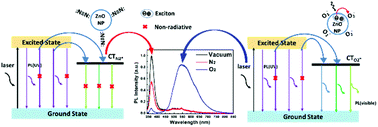The quality of solution-processed zinc oxide (ZnO) nanoparticles (NPs) is often correlated with their photoluminescence (PL) spectral characteristics. However, the reported PL spectral characteristics lack consistency and remain controversial. Here we report that “defect-emission free” PL spectra can even be obtained in thin films composed of as-synthesized ZnO NPs. It is found that both the PL spectral line-shape and intensity are extremely sensitive to nitrogen and oxygen. By conducting time-dependent PL (t-PL) and photothermal deflection spectroscopy (PDS) measurements under vacuum and different gases, it is proposed that both inert (N2) and reactive (O2) molecules can be absorbed on the ZnO NP surface and induce charge transfer (CT). The CT states induced by N2 are non-radiative which significantly reduces the band emission. Whereas the CT states induced by O2 are radiative at the visible region, and the exciton transfer is efficient which increases the overall PL quantum yield. Owing to such effects, the previously reported correlation between defects and PL emission becomes questionable and needs to be revisited. Particularly, the visible emission from the ZnO NPs is proved to be facilitated by external effects, instead of direct recombination from defect states.

